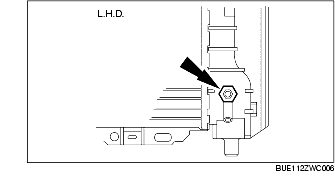ENGINE COOLANT REPLACEMENT [AJ (3.0L Duratec)]
id0112008006a2
Draining
-
Warning
-
• Never remove the radiator cap or loosen the radiator drain plug while the engine is running, or when the engine and radiator are hot. Scalding coolant and steam may shoot out and cause serious injury. It may also damage the engine and cooling system.
-
• Turn off the engine and wait until it is cool. Even then, be very careful when removing the cap. Wrap a thick clean rag around it and slowly turn it counterclockwise to the first stop. Step back while the pressure escapes. When you are sure all the pressure is gone, press down on the cap using the clean rag, turn it, and remove it.
-
Note
-
• About 80% of coolant capacity can be recovered from the vehicle. Dirty, rusty or contaminated coolant requires replacement.
1. Release the pressure in the cooling system by slowly turning the cooling system cap one half turn counterclockwise. When the pressure is released, remove the cooling system cap.
2. Remove the splash shield (RH).
3. Place a suitable container below the radiator drain plug.
-
(1) Loosen the radiator drain plug and drain the engine coolant.
-
(2) Tighten the radiator drain plug.
-
Tightening torque (L.H.D.)
-
1-2 N·m {11-20 kgf·cm, 9-17 in·lbf}
Filling and Bleeding Air
-
Caution
-
• Use engine coolant at a concentration that meets the environmental conditions in which the vehicle is driven, otherwise engine damage could occur.
-
• If the coolant temperature becomes too high, stop the engine to prevent it from overheating.
1. Add the correct engine coolant mixture to the coolant reserve tank until the coolant level is between the F mark or full level line and L mark or low level line.
2. Select the maximum heater temperature and blower motor speed settings. Position the control to discharge air from vents in dashboard.
3. Start the engine and allow it to idle. While the engine is idling, verify that hot air flows from the vents.
4. Start the engine and allow to idle until normal operating temperature is reached. Hot air should discharge from vents. The engine coolant temperature gauge should maintain a stabilized reading in the middle of the NORMAL range and the upper radiator hose should feel hot to the touch.
-
Caution
-
• If air discharge remains cool and engine coolant temperature gauge does not move, the engine coolant level is low in the engine and coolant must be added. Stop the engine, allow it to cool and fill the cooling system.
5. Stop the engine and allow it to cool.
6. Inspect for coolant leakage. (See ENGINE COOLANT LEAKAGE INSPECTION.)
7. Check the engine coolant level in the coolant reserve tank and fill it if necessary. (See ENGINE COOLANT LEVEL INSPECTION.)
